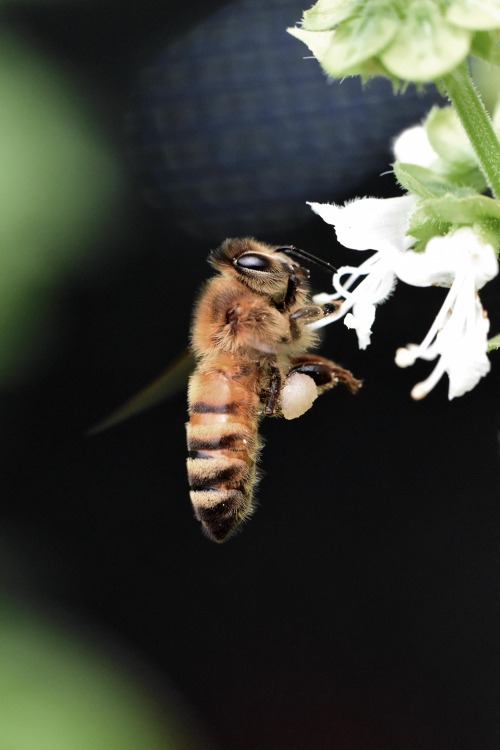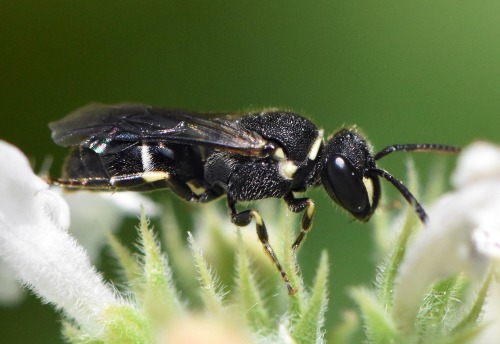
In conversation with Ryan Whyte
Behind the scenes of the 2021 OCAD U Pollinator Photo Exhibit’s winning photo.
Post by Victoria Ho, Sustainability Coordinator
Photo of Ryan Whyte in his garden © Jennifer Purtle. All other photos © Ryan Whyte
Pollinators reveal otherwise invisible connections between a garden and its urban context.
Today we are featuring Ryan Whyte, winner of the inaugural OCAD U Pollinator Photo Exhibit. The purpose of the exhibit was to encourage the OCAD U community to be curious about their own backyards and to celebrate the hundreds of pollinator species that can be found close to home in a range of habitats. We were thrilled by the responses and the creative captions that captured joy, silliness, and reverence for our wonderful pollinators that hold up our ecosystems and food systems.
Name: Ryan Whyte
Title and role at OCAD U: Chair, BA Honours Program in Visual and Critical Studies, Associate Professor, Faculty of Arts & Science
VH: Why pollinators? What sparked your interest in photographing pollinators?
RW: My partner and I maintain a small container garden. At a certain point I became obsessed with the behavior of pollinators in our garden and realized that they constituted a fantastic photographic subject and a fascinating subject of research. Pollinators are interesting for many reasons. Their proximity—their presence just outside our door, and in any urban garden—is a reminder of the urban networks of life that we usually ignore as we go about our business. Urban planning, for instance, because it is driven by developers, almost never takes the presence of nature into account, and yet cities host important ecosystems. Pollinators reveal otherwise invisible connections between a garden and its urban context.
Pollinators are also fascinating from an evolutionary perspective. The symbiotic relationship between plant and pollinating insect is a result of co-evolution, a dramatic example of a staggeringly complex network of mutually imbricated developments within a dynamic evolutionary process. I am not a scientist, but a historian, and for me this symbiosis and its evolutionary context and history is interesting and humbling because its immense complexity echoes, and indeed surpasses, that of historical events, and the challenge of understanding it echoes and surpasses that of understanding a historical event through the multidirectional interrelationships of its context and its past. Just as the complexity of the natural world will always at some point escape our grasp, so with the complexity of history.
Another lesson we can take from pollinators lies in the convergence of systems of signification in the act of pollination. Pollen is both food and reproductive material. Its operation depends on multiple forms of signification converging on the same site, whether the visual signalling of flowers (extending beyond human vision into the UV range perceptible by many pollinators), the chemical communication of plants, the markings of insects (one kind of pollinator, the hoverfly, visually mimics bees and wasps), electrical communication between bees and flowering plants (we are just beginning to learn about this phenomenon), or insect social communication such as the famous dance of the bees. This should be interesting to artists, because it suggests a model of complex, multivalent signification that puts the simplistic, reductive language of so much contemporary art and literature to shame.
VH: Pollinators are amazing. 75% of the world’s crops depend on them. They enable flowering plants to reproduce. They prevent soil erosion. They are both critical to combating climate change and are under threat due to climate change. Do you have any climate action strategies you can share with us?
RW: If you have the means to plant a garden, you can help pollinators. Easy-to-grow, common garden plants that attract many kinds of pollinators include mint, catnip, oregano, basil, tomatoes. Unlike most self-respecting gardeners, I let everything bolt, because I want my plants to blossom and attract insects as soon as possible. The very best thing you can do is plant species native to your region, since these will draw native pollinators. The Xerces Society provides excellent resources:
https://xerces.org/bring-back-the-pollinators
Another thing you can do, whether you have the means to plant a garden or not, is familiarize yourself with local pollinators. I recommend the iNaturalist app and site. This allows you to photograph insects, upload your photographs and connect with an enormous network of naturalists who will help identify them. Your photos and identifications can then be used by scientists. This is an amazing example of citizen science, producing millions of data points that sustain research in new ways and improve our understanding of the natural world.
The best way to help pollinators is first to understand them.
There is a wealth of information that a layperson can glean from citizen science; for example, if you encounter a species unfamiliar to you, you can use the app to see how many individuals have been identified in your region and find links to in-depth information about that species. I began using iNaturalist last summer, and to date have documented and identified 85 species of insect in our tiny container garden on the fifth floor of a downtown Toronto apartment. This has prompted me to research these species, to learn, for example, which ones are native to the region, and which have been introduced by humans, thus enriching my understanding of the Toronto ecosystem and the challenges it faces. The best way to help pollinators is first to understand them.
VH: Your previous research subjects have included fashion, gastronomy, and cross-cultural exchange in eighteenth-century print culture. Do pollinators relate to your research or figure into your teaching at OCAD U?
RW: Pollinators relate to my research on the history of food and its representations in art. I would say that my photographs relate to my research on and teaching of 18th-century art, in their appropriation of rococo aesthetics, and engagement with Enlightenment ideas about the perception of nature and the aesthetics of wonder. At the same time, photography, gardening, and amateur entomology are an escape from the pressures and constraints of academic life. We all need hobbies as vehicles for passions, for inspiration, to find different ways of thinking and being. For me, nature, even in the smallest urban garden, is infinitely restorative.
VH: There are over 360 native bee species living within the GTA and the average Toronto yard apparently hosts 50 bee species. Yet, the active lives of pollinators are often quietly underway without human knowledge. What do you hope that viewers will learn or appreciate from these images?
RW: I hope that viewers will enjoy a sense of awe and beauty in the natural world that I find so moving, and such a balm for the soul, and that they will gain a new awareness of the insects to which we have so many connections despite our ignorance and destruction of the natural world.
VH: Where do you live and what locations feature most frequently in your pollinator photos?
RW: I live in downtown Toronto, quite close to OCADU. All my photos are shot in our small container garden on the fifth-floor terrace of an apartment building.
VH: What equipment do you use? Any advice for shooting images of pollinators?
RW: I use a DSRL and a macro lens. These are far from the top of the line, which is a reminder that your photographs depend more on what you do with the gear than on the gear itself. You can take incredible insect photos with a cell phone and a cheap macro lens attachment.
Photographing insects is difficult. My best advice is practice, practice, practice. The joy of digital photography is that you can take thousands of photos, as you learn, at no expense. Over time, you will become familiar with the possibilities and pitfalls of different camera settings. A challenge of macro photography is its extremely shallow depth of field, and a challenge of insect photography is that insects move quickly. So, you must experiment with shutter speeds, aperture settings, ISO settings, ways of angling the camera relative to the insect body, etc. You can use a flash, which allows a smaller aperture and wider depth of field, and freezes rapid movement; or more advanced techniques like focus stacking, and more advanced gear associated with extreme macro photography such as focus rails, microscope lenses, etc. (Because I am interested in a natural aesthetic, I don’t use a flash, nor use the techniques of scientific and laboratory photography.)
With practice you also learn to identify some species by sight, which allows you to become familiar with how they move, how skittish they are, how to approach them, what time of day and in what weather they fly, which plants they like, etc. Macro photography reveals details imperceptible to the naked eye, and in so doing trains the naked eye to perceive things it did not see before. For me this is the essence of insect photography, a practice that imparts an intimate, embodied knowledge of the natural world and prompts still further research into each of the species I encounter. The opportunity to learn is limitless.
My gear: Nikon D5600, DX Micro Nikkor 85 mm f/3.5, a cheap set of extension rings (I usually use the 36mm), and a set of close-up (macro) filters that I rarely use. My shots are all hand-held with no flash.
———–
Thanks Ryan for sharing about your world of pollinators! You can check out more of Ryan’s images amongst the other photo submissions online at the 2021 OCAD U Pollinator Photo Exhibit.
Learn more about sustainability at OCAD U: www.ocadu.ca/sustainability
thememorare liked this
thetinymagician reblogged this from ocadusitespecific
ocadusitespecific posted this
Behind the scenes of the 2021 OCAD U Pollinator Photo Exhibit's winning photo....Post by...



